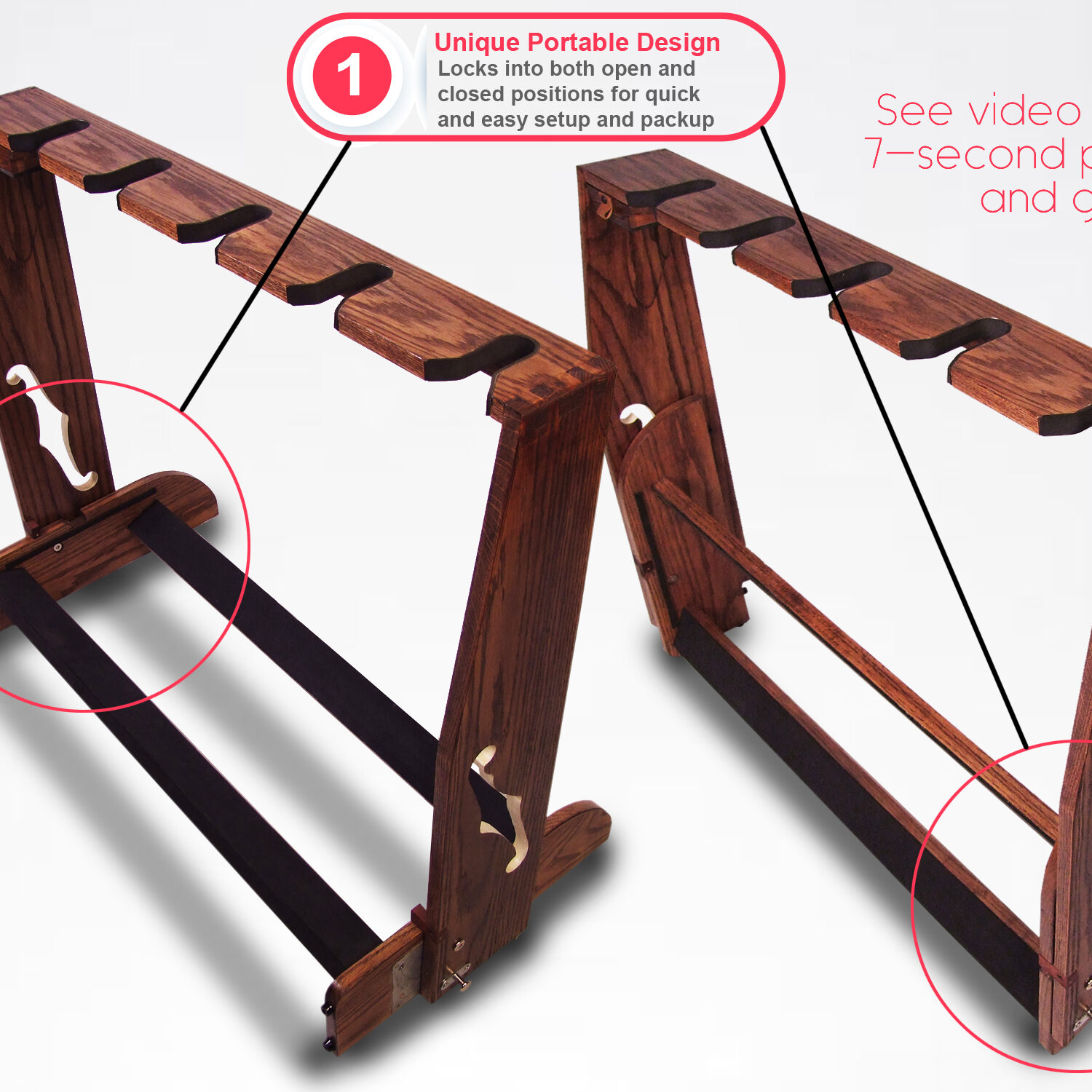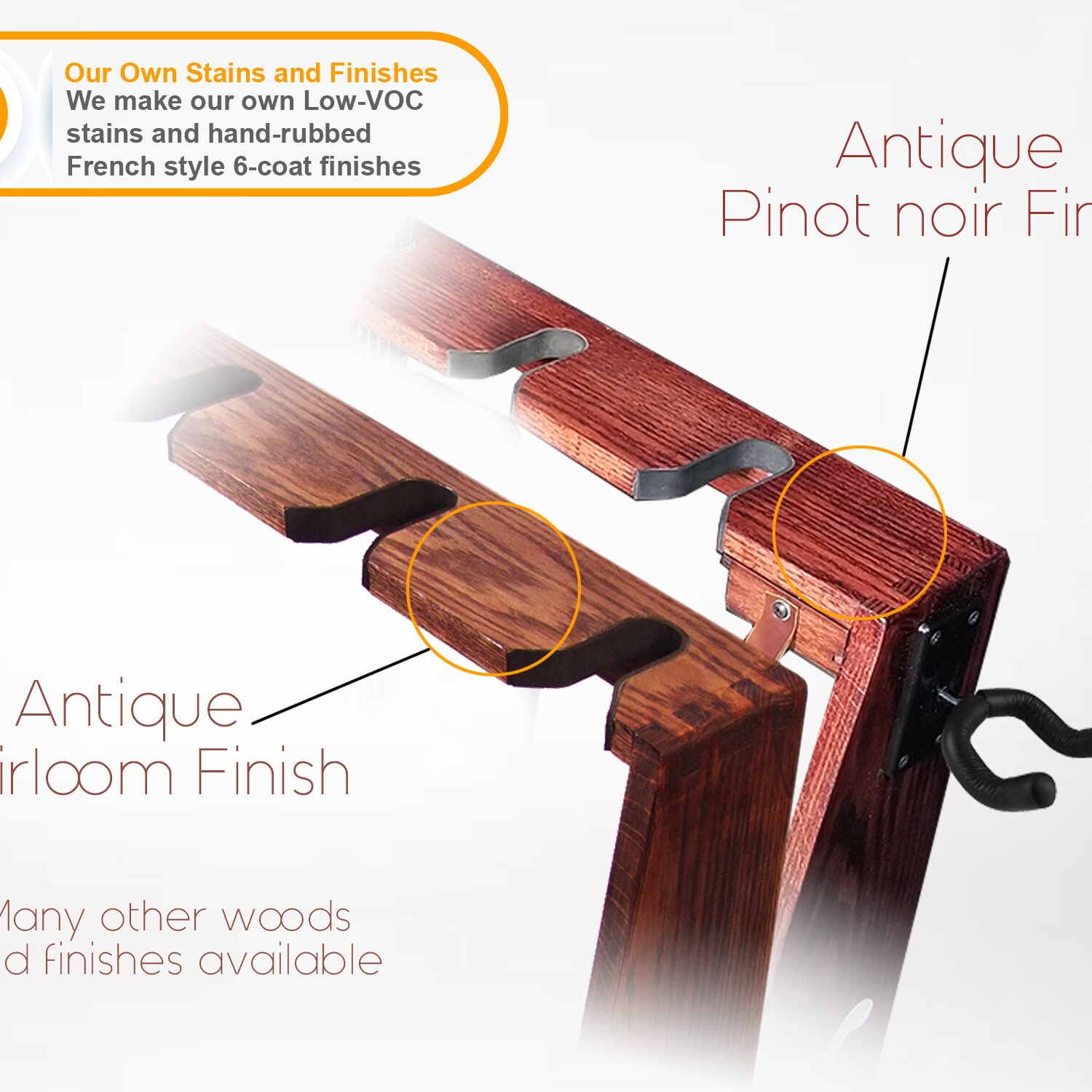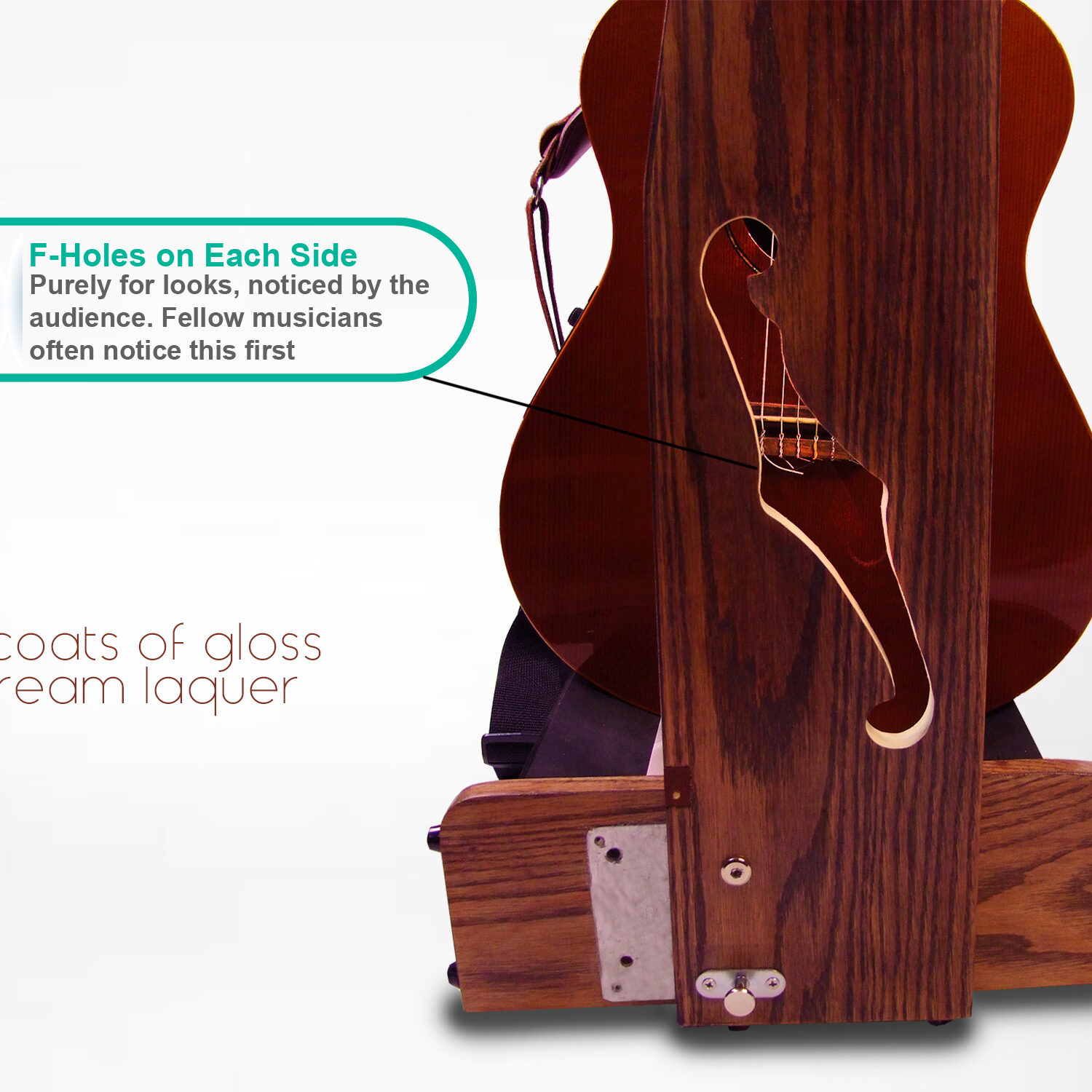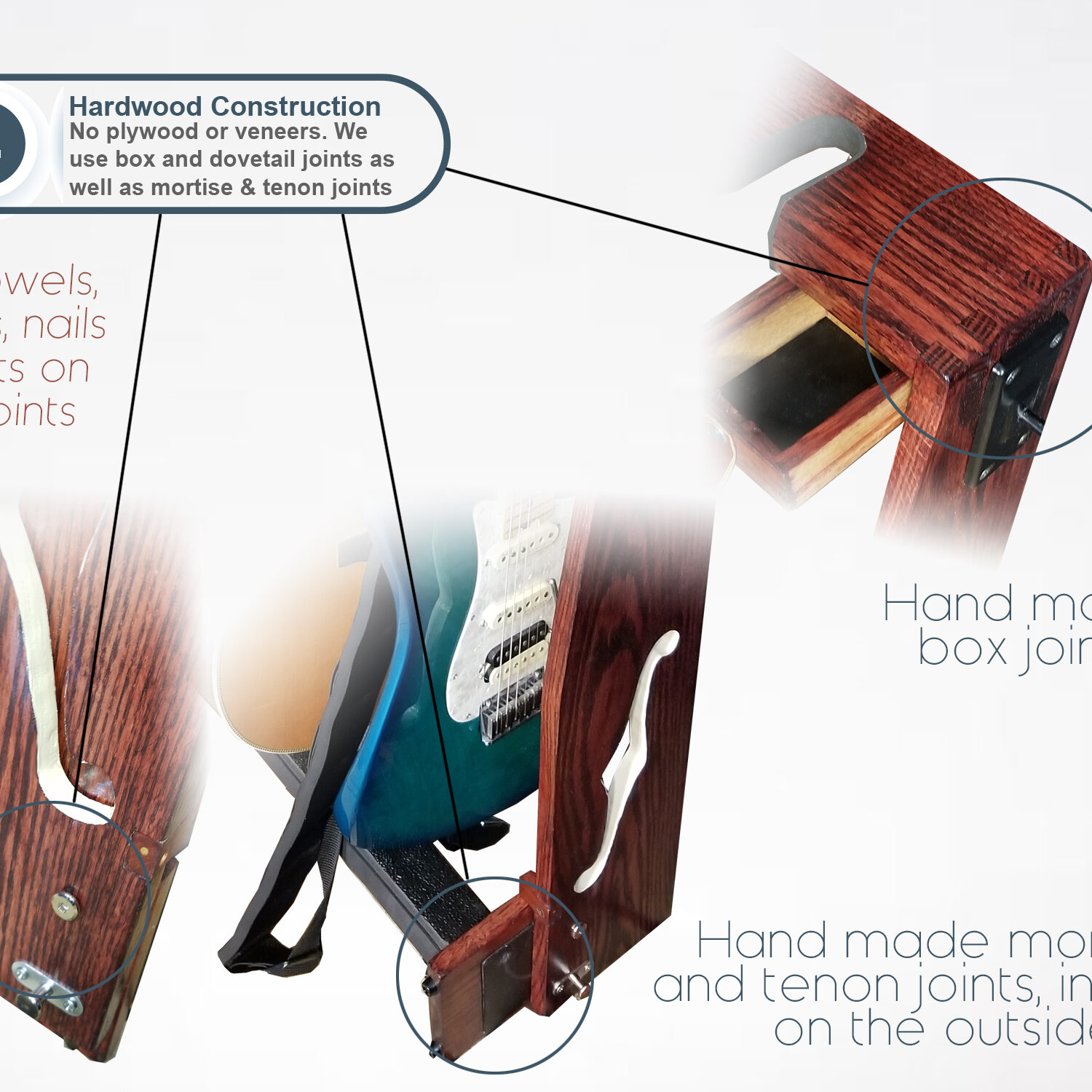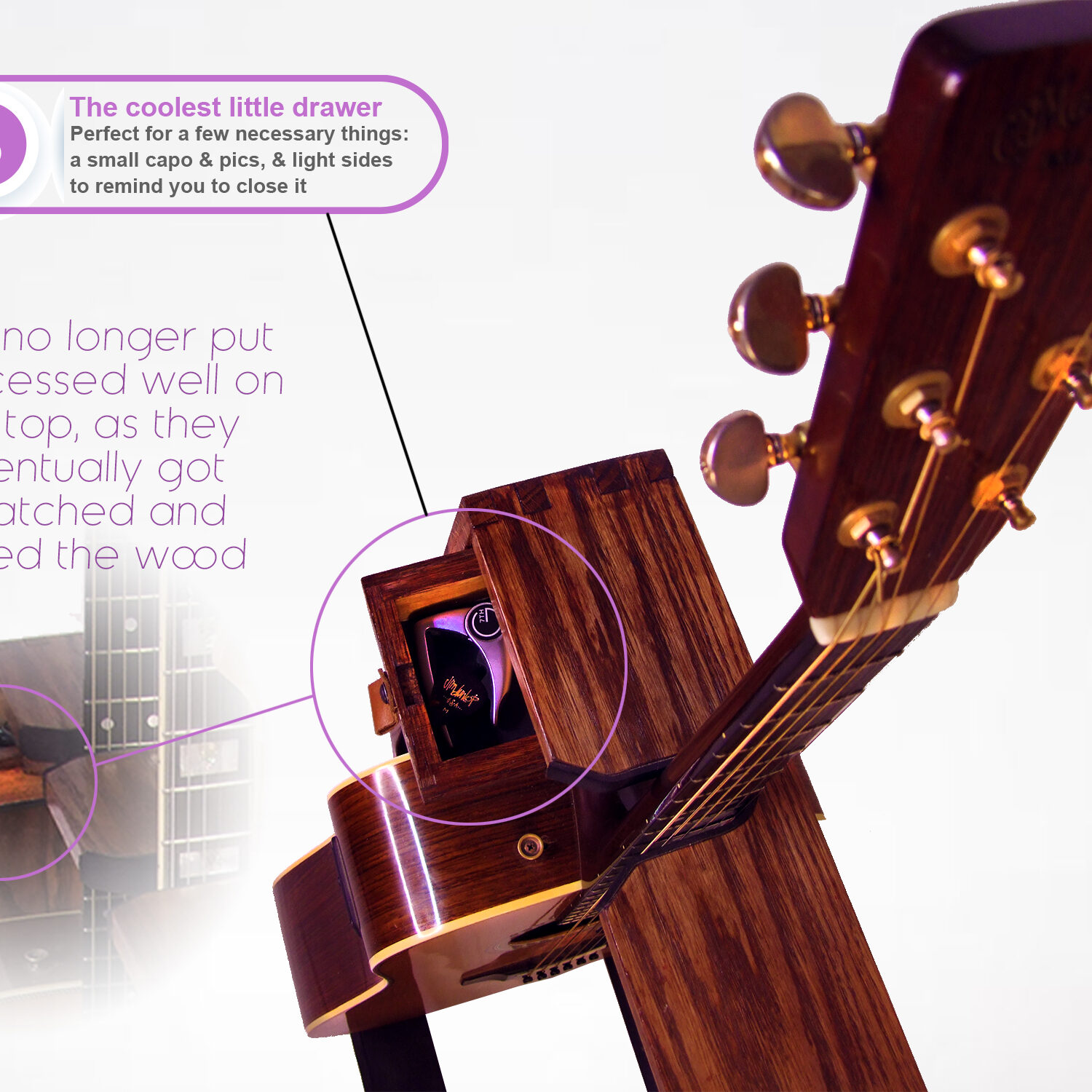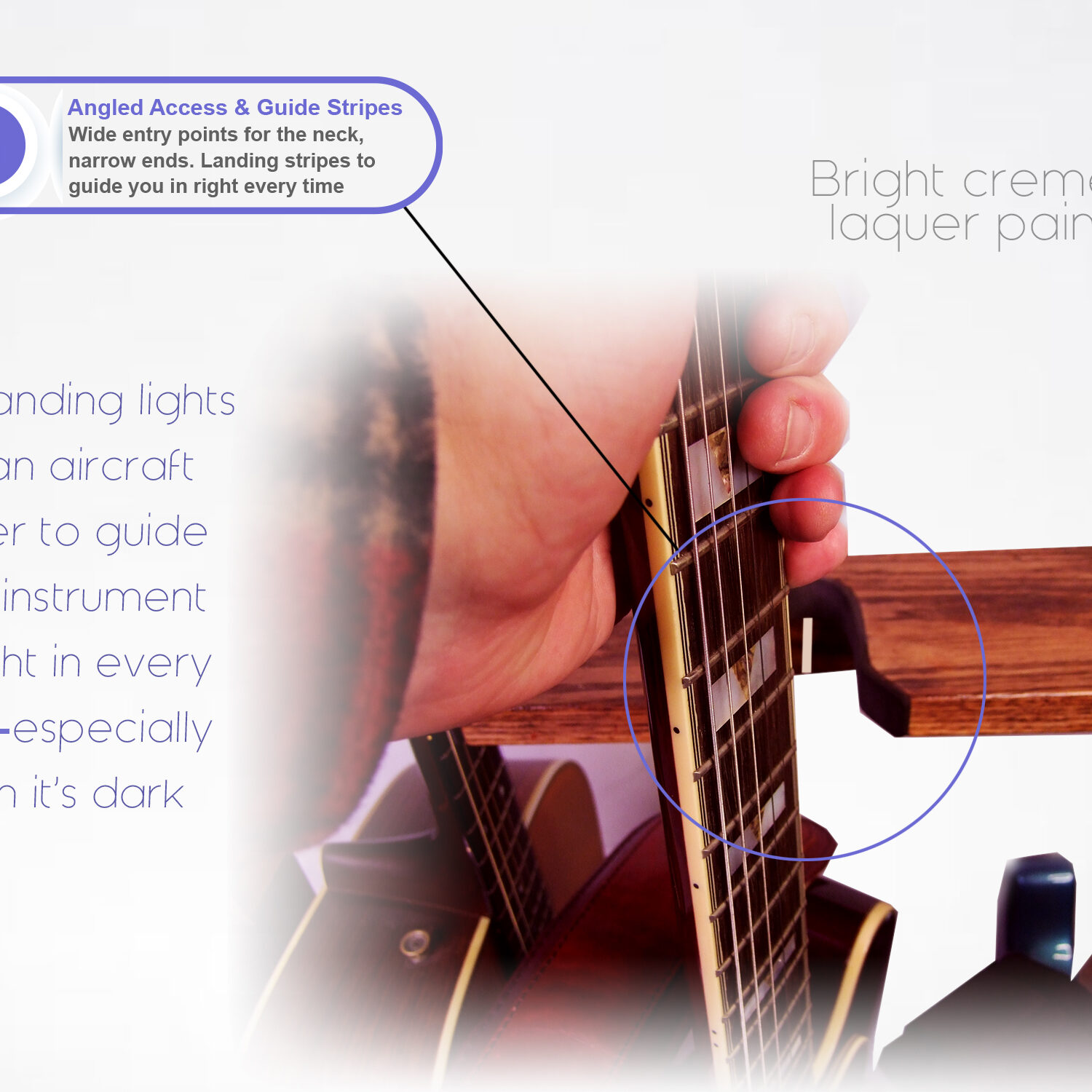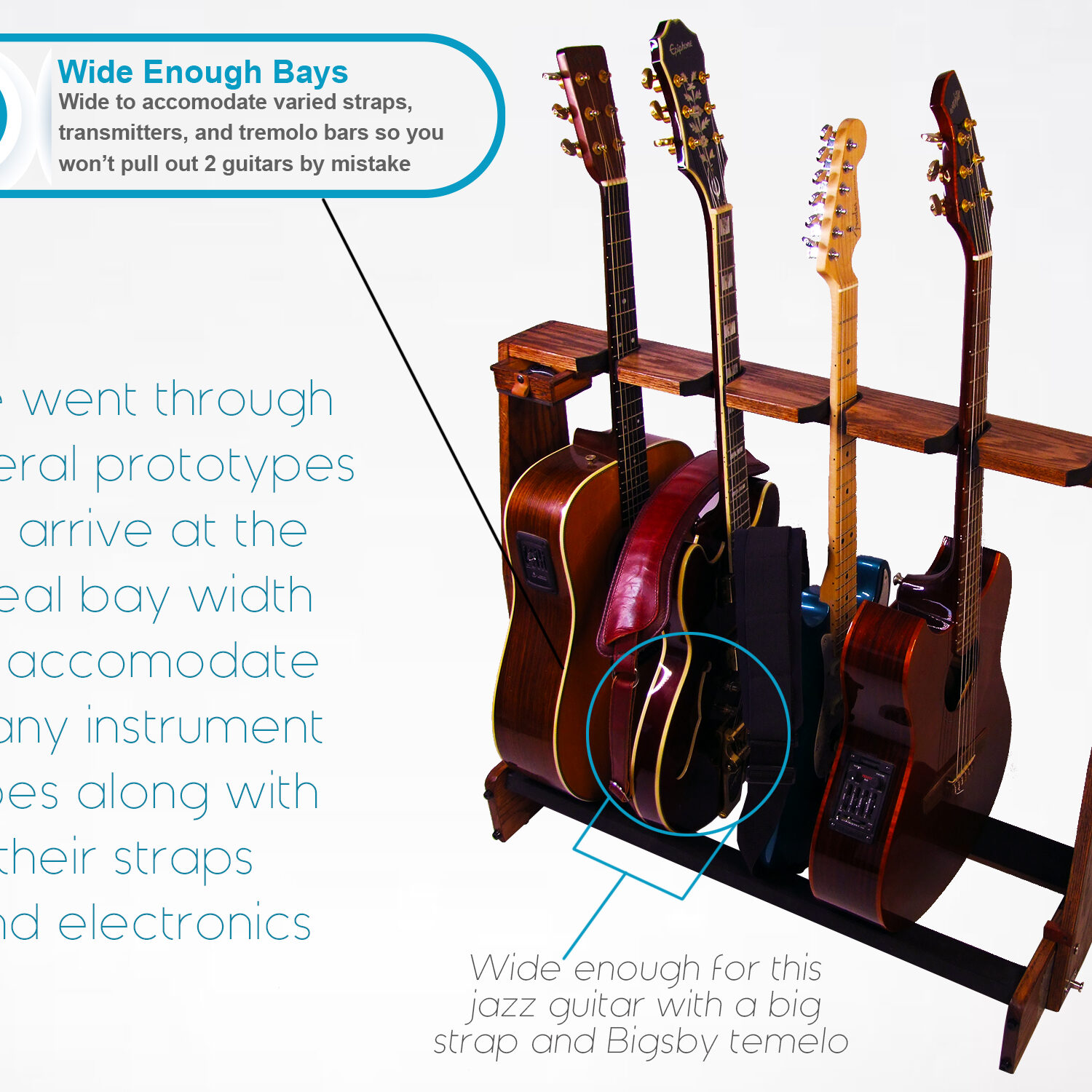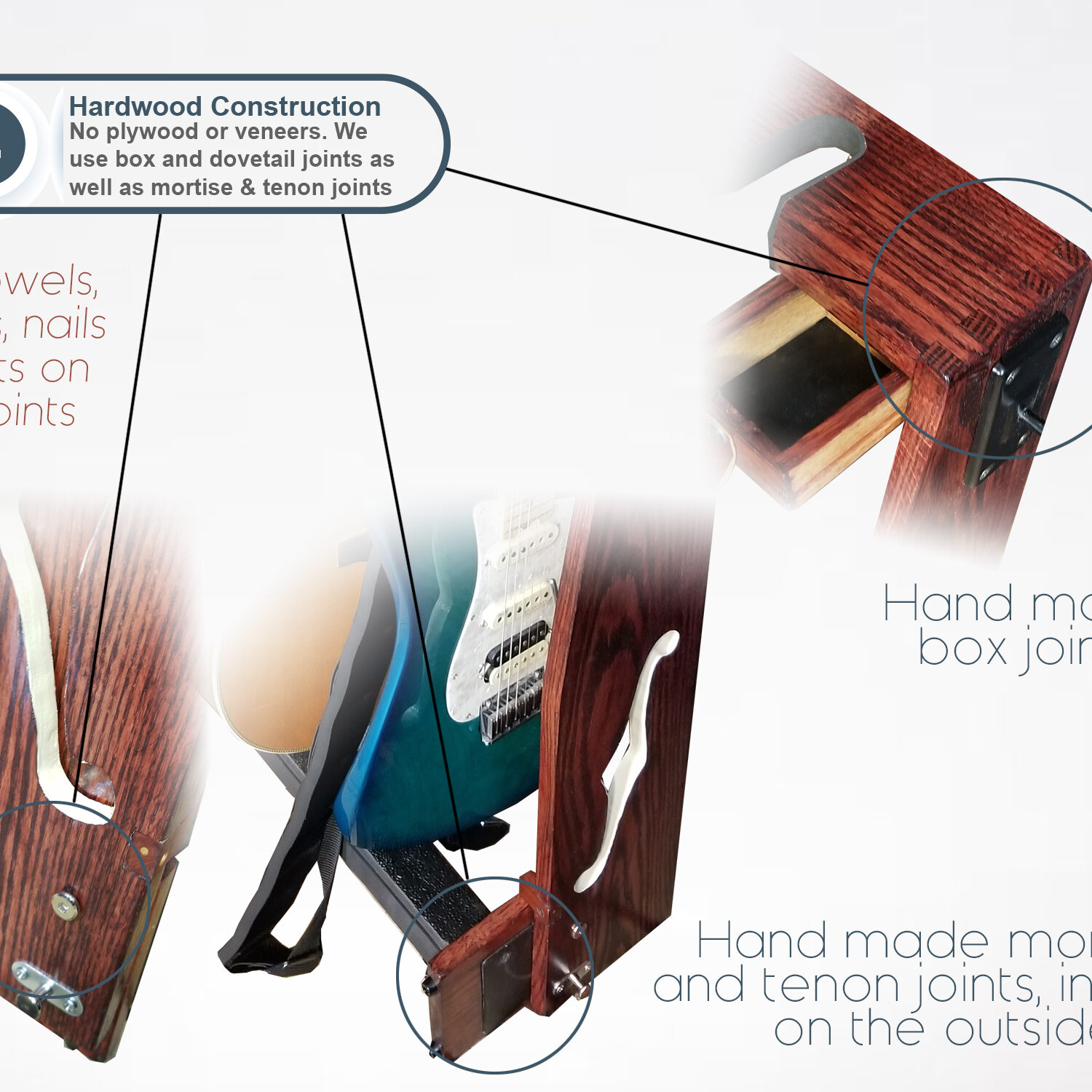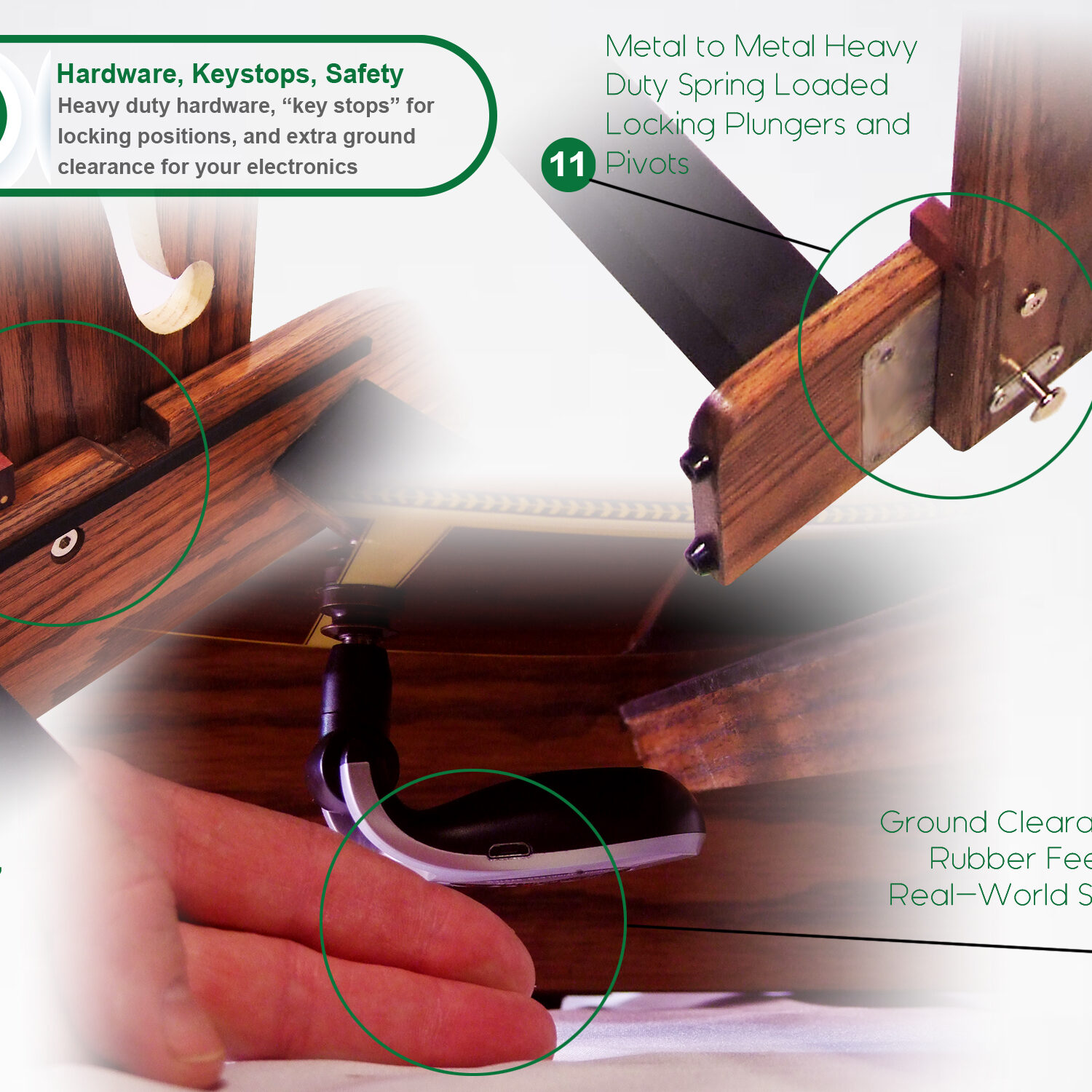All Original Features—Made for Professionals
Based on decades of studio recording work and live performances, we've been studying all the things we'd like to see in a stand and made ours based on all that experience. Here are 13 of the key features that make these stands unique:
1. UNIQUE PORTABLE FOLDING STAND
Having a nice guitar stand shouldn't have to mean it can't be portable. The uniquely designed base unlocks and rotates into a vertical locking position for quick and easy transport and vertical storage on a gig or in the studio. This is our own design. See the video.
2. OUR OWN STAINS AND FINISHES


4. HANDMADE HARDWOOD CONSTRUCTION AND JOINTS
• 𝗡𝗼 𝗽𝗹𝘆𝘄𝗼𝗼𝗱 𝗼𝗿 𝘃𝗲𝗻𝗲𝗲𝗿𝘀 𝗶𝗻 𝘀𝗶𝗴𝗵𝘁 𝗵𝗲𝗿𝗲.
We use the stands ourselves and want them to last, be safe and look beautiful. Veneers, plywood and softwoods can be made to look good, but they wear out very quickly and come apart. The only exception is our Japanese Shou Sugi Ban burnt wood style, as pine is best for this design. Great for home or studio, not recommended for regular gigging.
• 𝗛𝗮𝗻𝗱𝗺𝗮𝗱𝗲 𝗝𝗼𝗶𝗻𝘁𝘀, 𝗠𝗮𝗱𝗲 𝘁𝗼 𝗟𝗮𝘀𝘁
We use no dowels, screws or nails at key joints. The top corners are box joints or dovetail joints. This makes the joints as solid as can be. The cradle is held in place by hand made mortise and tenon joints that are invisible from the outside. This makes for an ultra-clean look and solid construction. It takes longer to build this way, so we trust our own $5,000+ instruments to it.
5. OUR OWN SUPER HAND DRAWER DESIGN FOR A FEW NECESSARY ITEMS
Having a well on the top of the stand gets scratched and worn out over time, or things get knocked out of it and lost. Instead, we made a little drawer with a leather pull that accommodates a few necessary things like a small capo, picks, slide or finger picks. It is designed to be slightly tighter when closed and stay closed. Additionally, the drawer sides purposely have a lighter stain - Why? Because when you go pack up in low light, it is easier to see if the drawer needs to be closed. This prevents banging the open drawer against anything while packing up.
6. ANGLES ACCESS POINT AND GUIDE STRIPES
Changing instruments should be quick, and in a dark area you shouldn't have to bang the neck of an expensive instrument against a narrow entry point, or have it stuck in a too-narrow back area. Padded and angled entry points make for a quicker placement in and exit out. The vertical light-colored stripe on the back plane guides the neck into place easily, even in limited light. Like a jet landing on an air craft carrier to guide your instrument in for a safe landing every time.
7. WIDE ENOUGH BAYS TO ACCOMMODATE STRAPS
Many stands seem fine. That is, until you start loading them up with instruments with thick and varied strap styles and wireless transmitters, then yank out two guitars when you only wanted one. Wider bays accommodate a variety of straps for easier placement entries, and safer grab-and-go exits. This is great for us live, as well as in the studio for instrument changes.
8, 9, 10 FUNCTION, EXTRAS, SPECIAL CRADLE
𝟴. 𝗢𝗣𝗧𝗜𝗢𝗡𝗔𝗟 𝗦𝗜𝗗𝗘 𝗜𝗡𝗦𝗧𝗥𝗨𝗠𝗘𝗡𝗧 𝗛𝗢𝗢𝗞𝗦
This will add a 6th instrument to the 5-instrument stand, and a 4th instrument to the 3-instrument stand.
This little addition was by suggested by a fiddle/mandolin player. This instrument hook holes are pre-drilled before shipment. Just carefully screw the hook on with the 4 provided custom screws. We recommend a manual screwdriver to prevent over tightening. This hook is great for violins, fiddles, mandolins, ukuleles, Guitaleles or Requintos (One client uses the 3-guitar small stand with a side hangar for his custom hand made one-of-a-kind Requinto.) The side hangar makes for very quick grab and go instrument changes - we even use this for instrument changes in the middle of a song. One client got instrument hangars on both ends for a mandolin and fiddle.
𝟵. 𝗕𝗔𝗖𝗞 𝗣𝗟𝗔𝗡𝗘 𝗙𝗢𝗥 𝗔𝗗𝗗𝗘𝗗 𝗦𝗧𝗔𝗕𝗜𝗟𝗜𝗧𝗬
The back plane serves two purposes. First, to laterally stabilize the stand when in use and add strength to the top bays. Second, to prevent side-to-side wobbling over time. The landing stripes are on this. It has handmade dowels underneath. Why? Mostly because they look so good, but they also make an even more stable bond to the top and sides.
𝟭𝟬. 𝗗𝗜𝗙𝗙𝗘𝗥𝗜𝗡𝗚 𝗔𝗡𝗚𝗟𝗘𝗗 & 𝗛𝗜𝗚𝗛-𝗤𝗨𝗔𝗟𝗜𝗧𝗬 𝗣𝗔𝗗𝗗𝗘𝗗 𝗖𝗥𝗔𝗗𝗟𝗘
One feature missing from all other stands was a natural lean towards the back of the stand in the cradle itself. The front cradle base is slightly higher and tilted more, the back cradle is at the angle the instrument naturally leans to after placement on the front cradle. This way it is easier to ensure all your instruments don't fall forward or have an unnatural tilt that can make them fall out when you're not there. When loaded with instruments, the longer tail ends of the base accommodate the shift in center of gravity towards the back. The inside vertical boards have foam padding along the length so your instruments don't bang on wood on either end. We stopped using carpet and soft foam on the cradle years ago, as they only get frayed and gouged up over time and then look awful. Instead, we use warehouse grade higher density foam that's still soft. Our friends who run a warehouse use this type for their workers to stand on all day and it's proven soft, durable, and very long-lasting. And it won't harm your instrument finish. We left instruments in a stand for 4 weeks straight to be sure.
11, 12, 13 HARDWARE, KEYSTOPS, SAFETY
𝟭𝟭. 𝗠𝗘𝗧𝗔𝗟 𝗧𝗢 𝗠𝗘𝗧𝗔𝗟 𝗛𝗘𝗔𝗩𝗬 𝗗𝗨𝗧𝗬 𝗦𝗣𝗥𝗜𝗡𝗚-𝗟𝗢𝗔𝗗𝗘𝗗 𝗟𝗢𝗖𝗞𝗜𝗡𝗚 𝗣𝗟𝗨𝗡𝗚𝗘𝗥𝗦 𝗔𝗡𝗗 𝗣𝗜𝗩𝗢𝗧𝗦
After having a few stands made by others collapse with guitars still in them, we built ours with steel locking plungers to keep it open and keep it closed. The spring plunger goes into a steel tube mounted permanently and hidden in the wood to prevent wood wear and tear. Plus, you hear a reassuring loud "click" when they lock into place. The inside end of the pivots are countersunk into the wood so they will never touch your instruments.
The outside and the inside woods never touch and grind since there is a steel or ABS plate. ABS is the same material your kid's Lego blocks are made of. You know - those indestructible blocks you tripped on as a parent that last for years and years? For the ABS models, there is a hidden steel plate around the steel pivot so that no wood is ever grinded on. After years of refinements, our design is still going strong after many years.
𝟭𝟮. 𝗛𝗔𝗥𝗗𝗪𝗢𝗢𝗗 𝗦𝗧𝗢𝗣 𝗞𝗘𝗬𝗦 𝗪𝗜𝗧𝗛 𝗦𝗢𝗟𝗜𝗗 𝗕𝗥𝗔𝗦𝗦 𝗥𝗢𝗗𝗦
We use hardwood mahogany "key" blocks to stop the base when reaching the opened or closed positions. Each key block has a solid brass rod in them to add more longevity to minimize wear and tear on the keys. These work in tandem with the locking plungers.
𝟭𝟯. 𝗚𝗥𝗢𝗨𝗡𝗗 𝗖𝗟𝗘𝗔𝗥𝗔𝗡𝗖𝗘 𝗔𝗡𝗗 𝗥𝗨𝗕𝗕𝗘𝗥 𝗙𝗘𝗘𝗧 𝗙𝗢𝗥 𝗥𝗘𝗔𝗟-𝗪𝗢𝗥𝗟𝗗 𝗦𝗜𝗧𝗨𝗔𝗧𝗜𝗢𝗡𝗦
We've used some stands that were good for just instruments. Once reality factors in and you add things like wireless body pack transmitters, wireless plugin transmitters or right-angle cables, many stands fail and grind your expensive equipment on the ground, or your guitar. Our stands elevate your instruments 2-3 finger heights above the floor. This accommodated all our situations, as well as uneven ground, uneven brick outdoor venues and more. The 8 high-quality rubber feet mean that your stand will never damage a nice floor, accommodate uneven surfaces, and keep your stand off the ground. In the studio, we put our folded stand next to a wall and it takes up very little space.
A variety of Woods
We use a variety of woods for your stand. Listing them all here would make you read all day. We can use wood that can fit your budget, all the way up to exotic heirloom woods. However, we recommend somewhat simpler woods that keep cost reasonable, speed up delivery, and can hold up to use. Some are: Oak, maple, mahogany, Brazilian rosewood, walnut and more. Let us know your favorite wood and we'll use that. So choose a wood that will keep it's beauty after staining and finishing.
This 5-instrument stand takes up far less floor space than 5 individual stands. Plus, it doesn't have tripod legs, which double as weapons to trip you while busy on a stage. You can add an instrument hangar to one end, or both. We use this stand regularly and have a hangar on the right for a mandolin.
Design Notes:
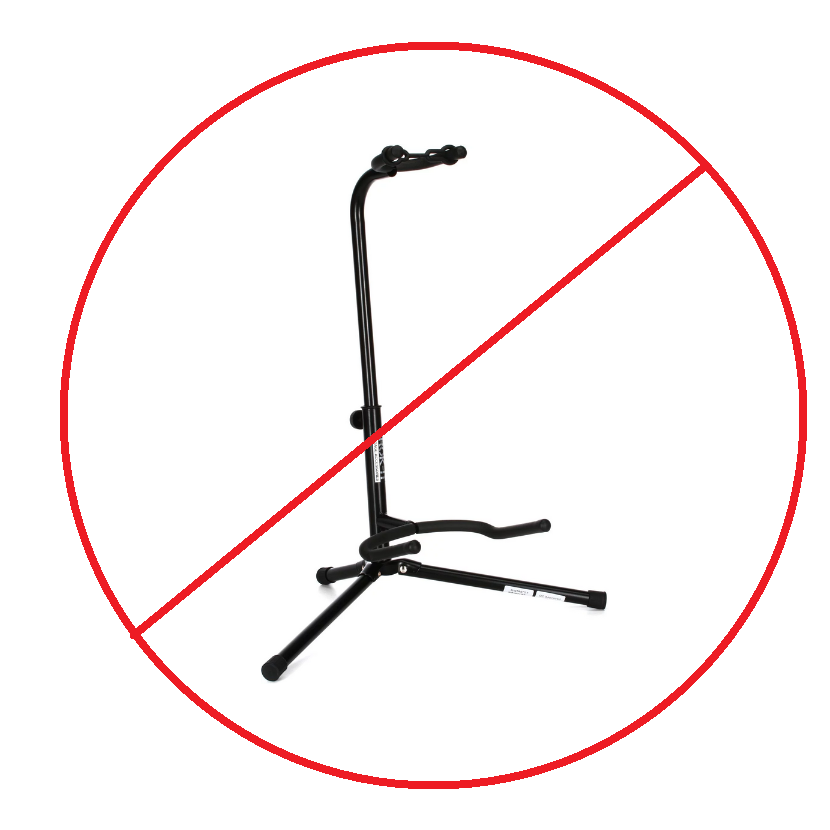
No More Tripods or way-out-there designs
We faced the facts: A good tripod stand works great. That is, until you trip on one of the legs in the dark and topple it over into another tripod and have domino instrument crashes on stage. Yes, it's happened to us. Never again. The 'way-out-there' designs were great looking, but impractical when it came to repeat gigs, set movements, cramped quarter gigs, studio storage space, and loading equipment into vans or moving trucks. Those stands got trashed quickly and were lost money. One centrally located stand takes up far less stage space than multiple tripods. This means less walking, hunting, between-song delays, and more playing music.
Real World Prototypes
We built several prototypes and used them in live gigs and studios to determine what worked best, refine the design, and eliminate things that got in the way when out in real world settings while still retaining the beauty and attractiveness of an instrument stand that makes a statement.
This is one of the older prototypes we put through it's paces on real gigs. The experience was critical as we moved toward our best design possible.
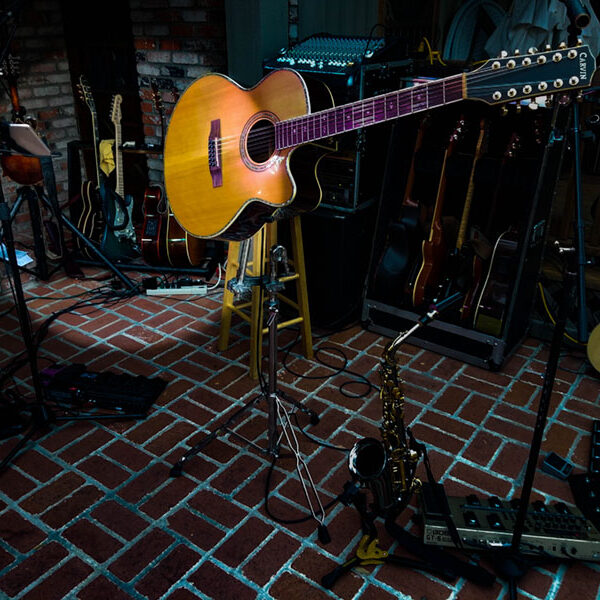
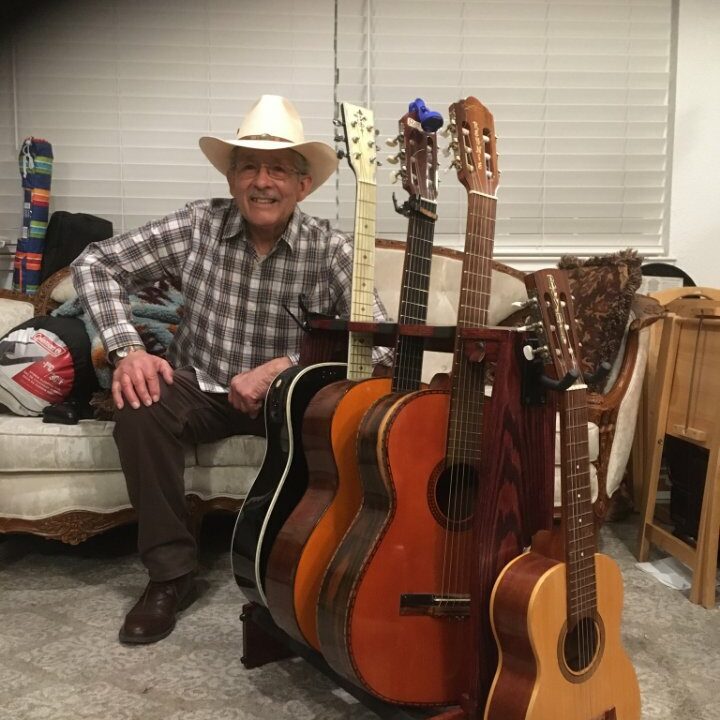
Recording Artist - Mexico
This Antique Pino Noit Red model holds 3 guitars and is slightly smaller. It has an optional instrument hangar on the right side, and holds his one-of-a-kind handmade Requinto Guitar. As you can see, Reynie is happy with his model, and sent me this snapshot.
This Stand
This is one of the prototypes we made a while back, and it is still going strong and in use in our studio. It gets a lot of use and is holding up great. We used pine for the sides and redwood for the top. It has a hand-carved leaf emblem on the side. If you want an emblem on yours too, let us know. We have a few varieties we make, and this add-on is permanently affixed to one or both sides of the guitar stand.
Let's work together
We make our stands because we love music and people. So let's build one together. Contact us with the stand you dream about and we'll make it just the way you like.
Prices start at $499, Depending on the wood or emblems you'd like, we'll get back promptly with an estimate. If you're on a really tight budget, we can make one with quality pine to reduce cost. But we recommend hardwoods instead.

